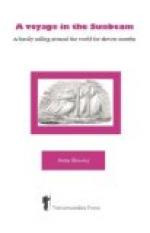Concepcion has suffered, and still suffers, much from earthquakes. The existing town is only thirty-five years old. The houses are all one story high only, and the streets, or rather roads, between them are wide, in order to afford the inhabitants a chance of escape, should their dwellings be thrown down by a sudden shock. In summer everybody rushes out into the street, no matter what hour of the day or night it may be, as soon as the first symptoms of an earthquake are felt; but during the winter, when the shocks are never so severe, the alarm caused is not so great. The old town was about two miles distant from the present site, near a place now called Penco, but after being demolished in the ordinary way, an immense wave rolled up and completely destroyed all traces of its existence.
We drove out to Puchacai, Mr. Mackay’s hacienda, a pretty little thatched cottage, surrounded by a verandah, in the midst of a garden, where laburnums and lilacs bloom side by side with orange-trees and pomegranates. Round the garden are groves of shady English oaks (the first we have seen since leaving home) and Norfolk Island pines, the effect of the whole scene being strangely suggestive of the idea that a charming little bit of English rural scenery has in some mysterious manner been transported to this out-of-the-way spot in Chili. The interior of the house, which is simply but tastefully furnished, and at the time of our visit was full of fresh flowers, arranged with an artistic eye to colour, bears the same indescribable homelike air. We were kindly received and regaled with luncheon, including, amongst other good things, fried pejerey (king of fish), deservedly so called.
In the afternoon we strolled about the garden, and looked at the farm and stable, and were shown the probable winner of one of the prizes at the forthcoming race-meeting. In the cottages on the estate some specimens of minaque lace were offered to us—a lace made by most of the peasants in this part of the country. It varies considerably in quality, from the coarse kind, used for covering furniture, to the finest description, used for personal adornment It is very cheap, wears for ever, and strongly resembles the torchon lace, now so fashionable in Paris and London for trimming petticoats and children’s frocks. The women also spin, dye, and weave the wool from the fleece of their own sheep into the bright-coloured ponchos universally worn, winter and summer, by the men in this country. These ponchos are not made of nearly such good material as those used in the Argentine Republic, but they are considerably gayer and more picturesque in appearance.
After dinner, there was nothing to do except to stroll about the town and buy photographs. They are extremely good in Chili—both views and portraits—but proportionately dear, the price being double what would be charged in London or Paris for the same thing.




